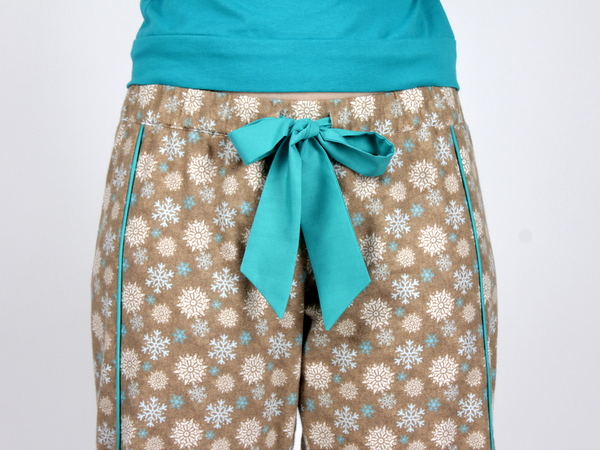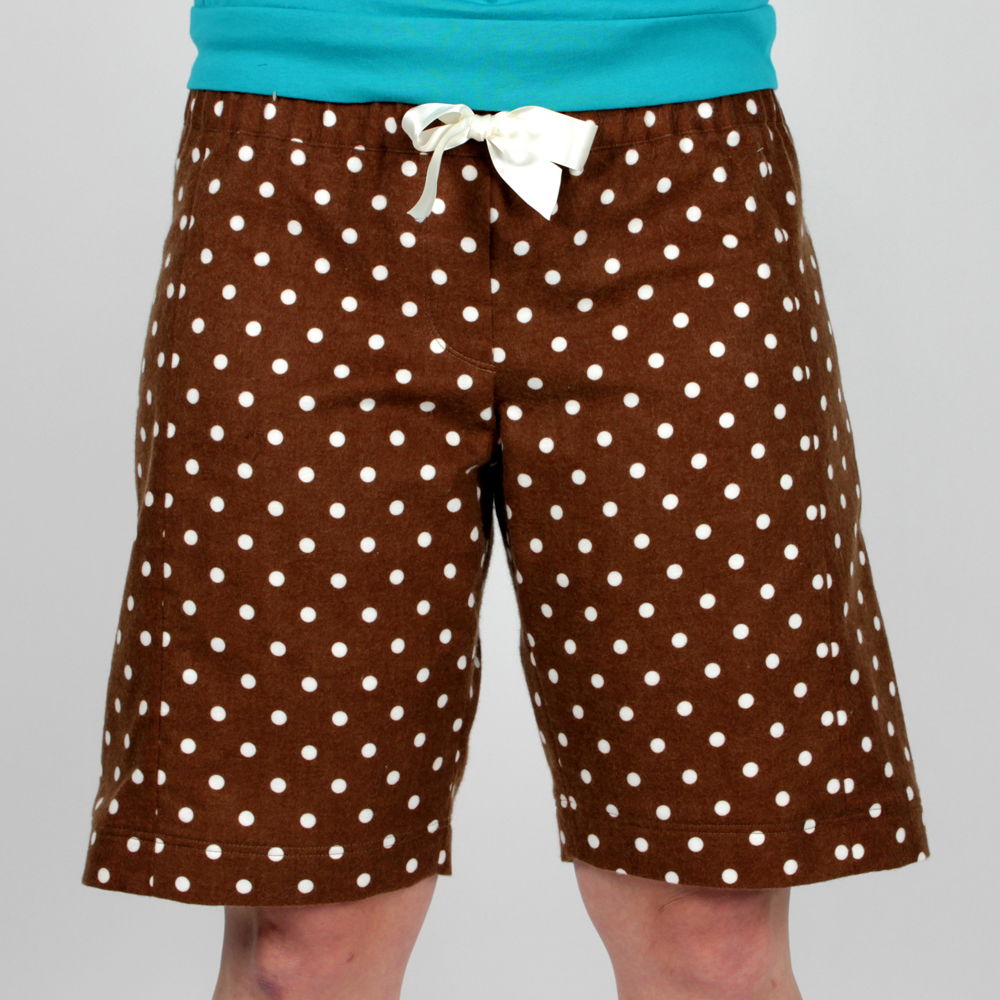A question came up and I thought the answer might be useful to many of you. It’s regarding the contrast fabric for the Tofino Pants. As you can see on the envelope back, there’s fabric requirements listed for both main fabric and contrast fabric.
So what is the contrast fabric used for?
The contrast is for cutting the fabric tie belt, and for cutting the bias pieces to make the fabric-covered piping.

You can see in the photo above we’ve used turquoise fabric for the contrast (a lightweight cotton) and tan snowflake fabric for the main fabric (a cotton flannel.)
So what does that mean? If you are skipping the piping and the fabric belt, you don’t need to buy any contrast fabric.

In this sample, there is no contrast fabric used at all. We’ve skipped the piping, and used a ribbon in the waistline along with the elastic.
Also, if you are replacing the piping with purchased piping or trim, and skipping the tie belt, you don’t need to buy contrast fabric either.
If you are replacing the piping with purchased piping or trim, but still want to sew the tie belt, you’ll need to buy contrast fabric but not the whole amount. (You’ll only need just over a yard, as opposed to the 1 3/4 yards required in the pattern. A yard and a quarter should cover it.)
Can you skip the ribbon and elastic altogether? Of course you can! Personally, I like to have the option to pull the waistline in tighter, and I like the extra detail of having a fabric tie or ribbon at the waistline. But you can skip the detail and just have elastic at the waist. You’ll want to skip the buttonholes on the waistband piece as they’re only there to thread the ribbon through.
Do you have any other questions about the Tofino Pants? Let me know and I’ll get them answered for you!
ps. Want to get your own copy of the Tofino Pattern? Click here to visit the store!

O my, those are super cute both ways!
This pattern is awesome – I can’t wait to order it and start sewing. One question I do have: I tend to like having lounge pants with side pockets – is there an easy way to modify this pattern to add those in?
I think so! I’d add inseam pockets to the seam down the front. Just borrow the inseam pocket piece from another pattern, like the Cambie Dress or any that has side seam pockets, and sew it in before closing up the seam.
I found a great tutorial for adding pockets on a blog from one of the Tofino pattern testers: http://suzybeesews.blogspot.com/2013/05/tutorial-sewaholic-1302-tofino-pants.html
I think these are adorable. What a great first project these Torfino pants would make!!!! I plan to teach my neice to sew and I think we will use your pattern!
That is awesome, and so nice of you to teach your niece to sew!
I’m surprised that you say you’ll still need 1 1/4 yards of fabric for a simple tie belt. Even 45″ fabric will give you a 90″ belt, assuming roughly 4″ wide (8″ folded in half), out of half a yard of fabric. Why so much fabric?
Hi Debbie! The belt is cut on the straight grain, so it’s a bit of a fabric hog. It’s better to cut the fabric belt with the grain so that it doesn’t stretch out and so the bow looks better. However you could certainly cut the belt across the fabric if it will fit to save fabric if you prefer! Hope this makes sense.
It makes sense if you’re using a knit but in a woven it’s not going to stretch whether it’s cut cross grain or lengthwise.
Actually, it does make a difference. Parallel to the selvedge – ie true grain – is always much more stable than cross grain. Cross grain in most fabrics, including tightly woven Tana lawn, always has a bit of give. That’s why waists of dresses stretch out if not stayed. Of course, it’s just a tie belt so if one doesn’t care one could cut cross grain.
Exactly! It isn’t a major issue either way for something like a tie belt, like Francesca said. It makes a teeny bit of difference, which is why the pattern is written that way, but you’re able to adjust to fit onto smaller fabric at your own discretion. Hope this helps!
I plan to make the pants in a fairly light summer fabric and use contrast piping but flat without the string inside. Think this will work?
Of course! Flat piping works just the same as corded piping. Sew it up the same way but without inserting the cord when you baste the raw edges together. You’ll just want to make sure to sew an even distance away from the piping, it’s a little more challenging to sew evenly when you don’t have the ridge of the cord to sew against.
I think will really cute crop length for wearing outside in the summer :)
If I wanted contrast side panels how much fabric would I need of main and how much for the side panels?
Thanks Tasia!
I saw your question on Twitter but will also respond here – you’ll need the length of the side piece, which is about 1 1/4 yards, 1.4 metres. If you plan to lengthen the pants at all you’ll want to add a little extra to that amount! Hope this helps.
Thanks for responding here and on Twitter Tasia, it’s appreciated.
Hi Tasia,
I’m fairly new to sewing and I’m attempting to make these pj’s. I decided to skip the piping and everything was looking good until I got to attaching the waistband and it appears my waistband is too short for the top of the pants meaning I would need to gather the top of the pants. I checked I cut the correct size and I have – is this normal? What do you suggest I do now?
Hi Kate! Did you use a 5/8″ (1.5cm) seam allowance on the seams, even without the piping? If not, if you perhaps took less seam allowance then when you add up the difference over all the seams that could be why the pants waistline is larger than the waistband. Other than that, it could be that your pants fabric has stretched during handling, if it’s loosely woven, has stretch or is a knit.
If it helps to see more photos and explanations, Karen from Did You Make That posted a complete Tofino Sewalong. You can see the waistband step here with additional photos! http://didyoumakethat.com/2013/06/20/pyjama-party-6-attaching-the-waistband/